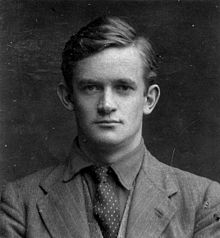- Douglases of Grangemuir
-
Grangemuir House was the seat of a junior branch of the Douglas family in Scotland. The house and attached estate was bought by Walter Irvine, a Scot who owned sugar estates in Tobago and Luddington House in Surrey. [1] It then passed to Irvine's daughter, Elizabeth, and her husband, Lord William Robert Keith Douglas, the fourth son of Sir James Douglas, 4th Baronet of Kelhead and younger brother of both Charles Douglas, 6th Marquess of Queensberry and John Douglas, 7th Marquess of Queensberry. Grangemuir House is located just north of Pittenweem in Fife, Scotland and is now a ruin in the Grangemuir Caravan Park.
The house was of French design and was constructed as a hunting lodge for the family in the 18th century. A notable feature was its exterior of marble which made the entire house glitter in sunlight. This marble facade is still visible today on the ruin around the windows - the rest of the building was clad in the 1970s with pebbledashed concrete as a cheap way of keeping the marble veneer attached, and to exclude damp.
Members of this branch of the Douglas family usually matriculated their arms with the mottos Jamais Arrière or Forward. However, in 1979, the present head of the family - Walter Francis Edward Douglas - was granted permission by the Lord Lyon to matriculate his arms with the motto Tendir and Trewe, as taken from the 15th century poem The Buke of the Howlat, by Sir Richard Holland, chaplain to Archibald Douglas, Earl of Moray.
O Douglas, O Douglas! Tendir and trewe.
History
Grangemuir House was given to Lord William Robert Keith Douglas (b: 1783, d: 1859) along with 2,700 acres (11 km2) of land surrounding it. On the 24th November 1824 he married Elizabeth Irvine (d: 1864).
They had three children, William (b: 1824 d: 1868), Walter (b: 1825 d: 1901) and Charles (b: 1837 d: 1918). The children founded the Douglas Cottage Hospital in St. Andrews in 1866 as a memorial to their mother, Lady William Douglas of Grangemuir - this memorial is still reflected in the contemporary St. Andrews Memorial Hospital, one of whose wards is still called the Douglas Ward.
The heir, Walter Douglas Irvine married Anne Frances Lloyd (d: 1917), the daughter of an Anglo-Irish doctor from Roscommon in 1870. They had six children:
- William Keith Douglas-Irvine (b: 1876 d: 1957)
- Capt. (Walter) Francis Douglas (b: 1878 d: 1950)
- Helen Florence Douglas MA (b: 1880 d: 1947), notable translator, historian & fiction writer and one of the first female graduates of St. Andrews University
- Rev. Henry Archibald Douglas BA MA (b: 1883 d: 1962), Parson
- Charles Gordon Douglas-Irvine (b: 1885 d: 1946)
- Capt. Edward Percy Douglas (b: 1886 d: ?)
- Lucy Christina Douglas-Irvine (b: 1874?? d: 1947?), Artist
- Elizabeth Douglas-Irvine (b: ? d: ?)
A number of these children were profoundly deaf.
Grangemuir reported annual revenues to the Treasury of £5298 in 1880 which was equivalent to about £256,000 in 2010.
The heir, Rev. Henry Archibald Douglas-Irvine married Beatrice Alice Mabel Gratix (d: 1976) in 1913 producing one heir in 1917, Walter Francis Edward Douglas. Henry's mother, Anne, was the last occupant of Grangemuir. The house and its lands were sold in 1931. The house continued in use until the 1970s whereupon it fell into ruin and subsequent conversion into a caravan park. His son, Walter Francis Edward Douglas (b: 1917), moved to Lincolnshire where he became an art teacher in Stamford School. He is the oldest surviving member of the family.
Like many of his close relatives in the 20th century, and like Helen Florence Douglas, Walter Francis Edward Douglas converted to Roman Catholicism.
The family who built Dunino church and primary school still have exclusive right of burial in one half of the Dunino church graveyard which is just south of St. Andrews and just north of Grangemuir. The family resumed its connection with the area in the 1990s and 2000s when two members attended the nearby St Andrews University.
Records relating to the Grangemuir estates, along with a small number of other family papers, can be found in the Special Collections Archive of St. Andrews University Library. They were rescued from an Edinburgh law firm in 1994 and subsequently donated to the University.
External links
- The lineage from THE ROYAL AND NOBLE FAMILIES OF BRITAIN
- Douglases of Grangemuir Family Photos
- Douglas of Grangemuir Papers, 16th - 20th Century (ms38603) [1] with the library record at [2]
- The Pitkin Family in Australia. Their ancestors were Thomas and Sarah Pitkin, butler and maid to Lord William Robert Keith Douglas in the 19th century.
- The source for the earnings of Grangemuir
- The obituary for Helen Douglas-Irvine
References
Categories:- Scottish clans
- House of Douglas and Angus
Wikimedia Foundation. 2010.







